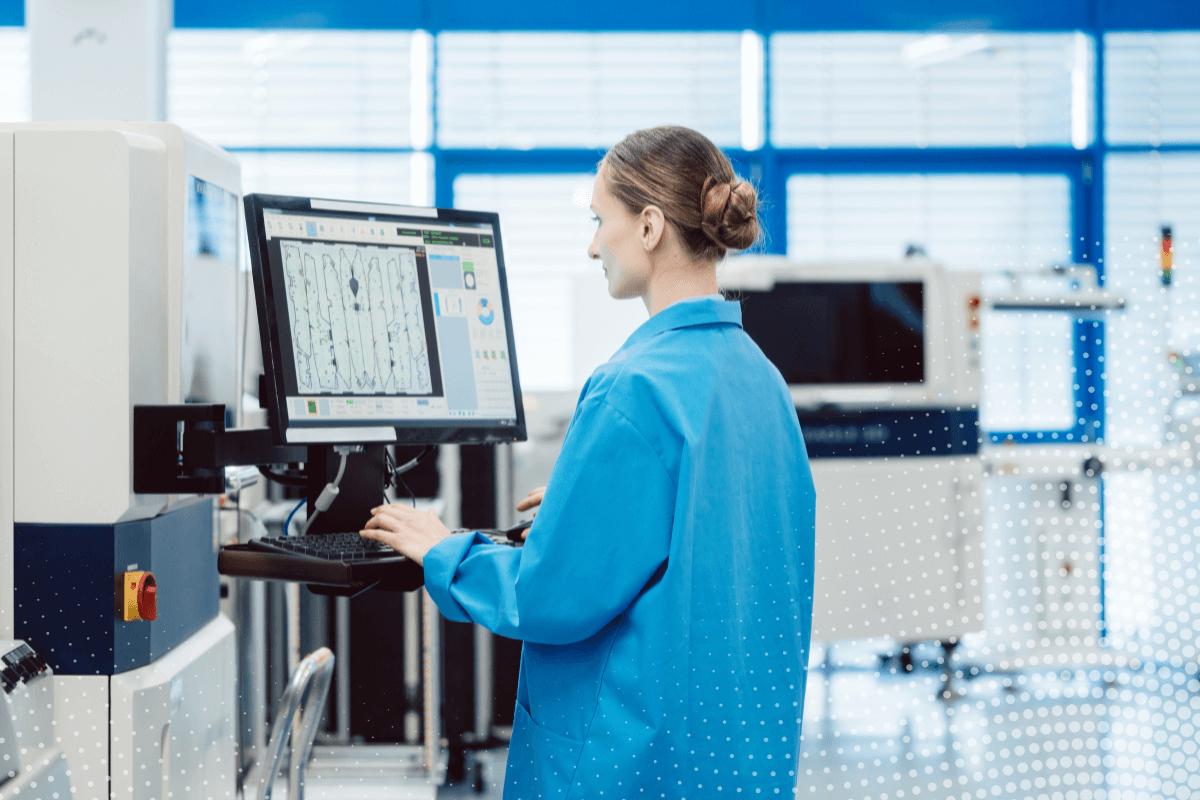If you’re new to the world of manufacturing and supply chain processes, the endless sea of acronyms can be intimidating. (Just know BOM and SCAR are far less threatening than they sound.)
For those of you struggling to keep up, bookmark this glossary with more than 50 day-to-day acronyms from the world of supply chain management. It may come in handy!
Supply Chain Acronyms Glossary
AVL = Approved Vendor List
Also known as the Approved Manufacturer List (AML), an Approved Vendor List (AVL) is the official register of third-party suppliers approved by the company, indicating that those suppliers comply with all the corporate requirements and specifications for the company’s products.
BOM = Bill of materials
One of the most commonly used acronyms in day-to-day operations, Bill of Materials (BOM) is the list of all raw materials that go into the final assembly of a product. Think of it more like the recipe of the product, rather than a bill you get at the end of a meal.
CAPA = Corrective Action Preventative Action
Corrective Action, Preventative Action (CAPA) is an investigative and problem-solving method used to address any issues in the product manufacturing process, ideally discovered via internal audits but also (less ideally) from customer complaints.
CAR = Corrective Action Request
A Corrective Action Request (CAR) is a request sent to a supplier or manufacturer when a nonconformity or defect is discovered in a product and an investigation is required to prevent future issues.
CM = Contract manufacturer
A Contract Manufacturer (CM) is an outside firm that specializes or focuses on the manufacturing or assembly of a part or all of a product, often hired by a company as a cost-saving measure.
CAD = Computer-Aided Design
Computer-aided design (CAD) replaces traditional drafting methods with a software that can design and render 2D and 3D models, increasing efficiency in the design phase and ultimately reducing lead time.
CAM = Computer-Aided Manufacturing
While CAD focuses on the design of the product, Computer-Aided Manufacturing (CAM) focuses on how it is made. Primarily utilized for the outcome of maximizing efficiency and decreasing inconsistency, Computer-Aided Manufacturing automates any step of the manufacturing process that uses computer-controlled machinery and software.
CFM = Continuous-Flow Manufacturing
Continuous-Flow Manufacturing (CFM) is exactly as it sounds—a manufacturing method wherein materials being processed are constantly moving through the production line. CFM is the opposite method of batch production, wherein materials only move through the production line at specified times or in specified amounts.
DAM = Digital asset management
A digital asset management (DAM) system is a digitally based hub for all of an organizations media assets, including branding graphics and product images. DAMs are most commonly used by branding, marketing, sales, and other commercialization teams in their customer-facing efforts.
DCR = Document change request
A document change request (DCR) functions as part of the change management process as the official signal to make adjustments where a problem in the product manufacturing procedure has occurred.
DHF = Design history file
A Design History File (DHF) contains all the records of the design phase of a product, encompassing every stage of the design, such as prior drafts, notes, data, and reports.
DHR = Device history record
A collection of records containing a product’s full production history, the Device History Record (DHR) includes the serial and lot numbers of the products produced, and any complaints or issues that are lodged against the product.
DMR = Device master record
An important reference for quality management, a Device Master Record (DMR) contains all the records regarding procedures and specifications for manufacturing a finished product used, including the bill of materials, design drafts, packaging and assembly instructions, source codes, and more.
ECN = Engineering Change Notice
An Engineering Change Notice (ECN) documents the official approval of a requested change as part of the change management process, authorizing the manufacturer to implement the change to the production.
ECO = Engineering Change Order
The Engineering Change Order (ECO) outlines a proposed change to the design in the engineering phase of a product, listing the parts affected and requesting review and approval from the manufacturers. Reasons include a problem that requires fixing, a part that becomes obsolete, or a replacement that could lower costs.
ECR = Engineering Change Request
As the first step in taking corrective action in the manufacturing process, an Engineering Change Request (ECR) is a request to propose improvements or problems with components or assemblies.
EDA = Electronic Design Automation
Used frequently by computer chip manufacturers, Electronic Design Automation (EDA), also known as electronic computer-aided design (ECAD), is software or a series of software tools used to design, develop, and render integrated circuit systems and printed circuit boards.
eIFU = Electronic Instructions for Use
Relating most commonly to medical device or medical technology products, Electronic Instructions for Use (eIFU) are digitally accessible Instructions for Use—a set of written guidelines or user manual for the patient or distributor.
ERP = Enterprise Resource Planning
Often thought of as the hub of business processes for product companies, Enterprise Resource Planning (ERP) is a method of business management that tracks activities like purchasing, inventory, and orders and effectively models and analyzes data across departments including finance, HR, distribution, manufacturing and the supply chain.
ESG = Environmental, Social, & Governance
An increasingly prevalent factor in decision making, Environmental, Social, and Governance (ESG) is an approach to supply chain management that considers the non-financial impact of production processes. With encroaching pressures from investors and consumers, leadership at product companies are integrating potential impact to climate change and sociopolitical issues into their supply chain analysis and overall governance.
FFR = Field Failure Request
A Field Failure Request (FFR) is a particular type of change request detailing a problem or non-conformity with the product that comes directly from the field management service, or a member of the field service team, in direct contact with the end users.
FFF = Form, Fit and Function
Engineers use the Form, Fit and Function (FFF) framework to look up an item’s identifying characteristics and match parts to the needs of the products. The FFF framework enables flexibility by allowing changes to be made without requiring documentation as long as the changes align with the form, fit, and function of the product.
GMP = Good Manufacturing Practices
As part of quality assurance, Good Manufacturing Practices (GMP) is a set of guidelines and best practices for managing each aspect of production to ensure that standards and regulations are met.
IoT = Internet of Things
The internet of things (IoT) refers to an interrelated set of computing devices, machines, and technologies comprising a system that shares and transfers product data without requiring manual inputs or implementation, thereby increasing efficiency and reducing development time.
JIT = Just-In-Time
For the purpose of reducing production time and improving efficiency, Just-in-Time (JIT) manufacturing is a supply chain strategy wherein raw materials are ordered to coincide with the production schedule minimizing inventory on hand.
MCO = Manufacturing Change Order
Going hand-in-hand with an Engineering Change Order (ECO), a Manufacturing Change Order (MCO) is a change order used specifically to make a manufacturing change to a product, as opposed to a change in design.
MCR = Manufacturing Change Request
A Manufacturing Change Request (MCR) is used to propose a change to the manufacturing process without requiring a change in the design of the product.
MDR = Medical Device Reporting
Medical Device Reporting (MDR) is a procedure implemented by the FDA to perform benefit-risk assessment and continually monitor the performance of medical devices and technologies after they have launched to market. The process requires mandatory reporting from manufacturers, including any product defects, adverse issues, nonconformities, or other problems with devices.
MES = Manufacturing Execution System
Important to the decision making and optimization of the production process, manufacturing execution systems (MES) are digital manufacturing programs used to document and trace the conversions of raw materials into finished products.
MRP = Material requirements planning
Typically implemented in a computer-based platform using demand forecasts and other data points, material requirements planning (MRP) is the process of preparing, scheduling, and controlling inventory and raw materials to be purchased for use in the manufacturing process.
MTBF = Meantime Between Failure
A critical maintenance metric for optimizing performance, meantime between failures (MTBF) refers to the average duration of time between mechanical or whole system breakdowns. MTBF factors into the safety, reliability, and efficiency of a particular piece of equipment and how it affects the production process as a whole.
NCMR = Non-Conformance Material Report
A Non-Conforming Material Report (NCMR) is submitted in the event that a raw material is found to be in some way noncompliant with the predetermined specifications required for the product. These reports can be submitted at any time throughout the material’s life cycle in the production process, from receiving to final inspection.
NPD = New Product Development
Enacted to leverage a market opportunity into a sellable product, New Product Development (NPD) encompasses all the phases of conceptualizing, research, designing, planning, supplier management, and manufacturing a new product to be brought to market.
NPI = New Product Introduction
Though the two often get confused, New Product Introduction (NPI) works in direct conjunction with New Product Development (NPD), except NPI refers specifically to the marketing, selling, and commercialization of a new product being brought to market. In a cohesive product value management approach, these two processes—NPD and NPI—would be fully integrated and occur simultaneously by building a single source of product information.
OEE = Overall Equipment Effectiveness
Overall Equipment Effectiveness (OEE) is a best practice that measures the utilization of raw materials, time, and machinery in the overall manufacturing process, offering a percentage score where 100% indicates each step of the production process is operating as efficiently and effectively as possible.
ODM = Original Design Manufacturer
Typically employed as a means of efficiency and reduced costs, an original design manufacturer (ODM) is a third-party company that will design and manufacture a product based on another firm’s specifications, which the latter will then rebrand for sale to their consumers.
OEM = Original Equipment Manufacturer
The Original Equipment Manufacturer (OEM) is another company that produces a product or part used by the secondary seller, who adds value by adjusting the product or adding a service to the original product for the consumer.
PDM = Product Data Management system
A fixture of product management databases, the Product Data Management System (PDM system) is used in product value management to house all current and approved CAD files, parts and assembly, models, and product drawings.
PIM = Product Information Management
A product information management (PIM) platform is a critical facet of product value management software that provides a single source for product information to be collected, maintained, and enriched. Product companies can create a full product catalog directly in a PIM platform as well as distribute product information and assets to multiple eCommerce and sales channels.
PLM = Product Lifecycle Management
From the initial design and prototype to the end-of-life delivery and service, product lifecycle management (PLM) is an application or software platform that manages product records, such as bills of materials, specifications, CAD files, revisions, and changes. PLM integrates people and business processes into the core development of a product.
PVM = Product Value Management
Originally developed by Propel Software as a new approach to product strategy, a product value management (PVM) platform is designed to connect commercial and product teams in one shared application space. A PVM platform such as Propel's optimizes the inherent value of a product by sharing insights across front office and back office teams, driving process efficiencies with contextualized collaboration, and engaging customers with compelling products and experiences.
QA = Quality Assurance
Quality assurance (QA) refers to any system or business process performed to determine whether a product meets specified requirements or complies with regulations in order to maintain standards set by the company and by governing bodies.
QC = Quality Control
Not to be confused with quality assurance (QA), quality control (QC) refers to the inspection process of a product or production process to determine whether it fulfills specifications and complies with regulations.
QMS = Quality Management System
Critical for both safety as well as customer satisfaction, a quality management system (QMS) is a collection of business processes and applications that maintain the standards and specifications of the production process through a series of policies, procedures, and controls.
R&D = Research & Development
Research and development (R&D) is a phase of the product development process that focuses on product innovation based on data from market research, product data, and consumer feedback. R&D is considered the driving force behind advancements in product development as well as an integral player in determining project budget and financial projections of the product’s performance.
RoHS = Restriction of Hazardous Substances
Relating to quality management especially, Restriction of Hazardous Substances (RoHS) is a mandate issued by the European Union for products sold within the EU, restricting the usage of six hazardous substances: lead, mercury, cadmium, hexavalent chromium, polybrominated biphenyls and polybrominated diphenyl ethers.
RMA = Return Material Authorization
Return Material Authorization (RMA) is a financial work order for the supplier or manufacturer initiated when a customer returns their product, whether due to damage or any other reason, in exchange for a refund, replacement, or credit to the consumer's account.
SCAR = Supplier Corrective Action Request
Supplier Corrective Action Request (SCAR) is a change request directed towards a supplier from a manufacturer requiring a resolution to an issue with a part, process, or component of a product.
SMED = Single-minute exchange of die
Critical for reducing downtime and smoothing out production processes, Single-minute exchange of die (SMED) is a method of lean manufacturing to reduce waste during the manufacturing cycle by providing efficient ways of converting from one product to the next.
SOP = Standard Operating Procedure
Necessary for increased efficiency and quality assurance, the Standard Operating Procedure (SOP) is a written record documenting and providing instruction for the steps included in a process or procedure.
SOW = Statement of Work
Part of the day-to-day routine of field service management, a statement of work (SOW) documents a given project’s requirements, including activities, conditions, deliverables, timelines, and payment terms detailing a vendor’s services provided for the end-user such as a consumer or patient.
TEEP = Total Effective Equipment Performance
A key production performance metric, TEEP (Total Effective Equipment Performance) is used to determine how much potential a production environment has based on the performance level of its current equipment.
VOC = Voice of Customer
Voice of the Customer (VoC) is a term used by marketing and commercialization teams as a catchall to describe the overall feedback from customers about a product. VoC includes customers’ experiences with the product as well as expectations for improvement.
Looking for more detailed definitions? Check out Propel Software's complete glossary of supply chain terms.



%20is%20Transforming%20Product%20Experiences.png)













